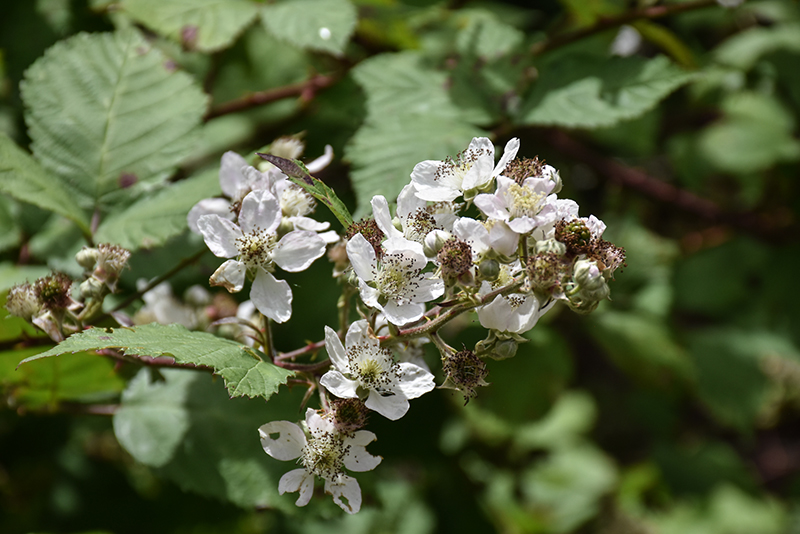PLANT FINDER
Height: 6 feet
Spread: 6 feet
Sunlight:
![]()
![]()
![]()
Hardiness Zone: 3a
Other Names: California Blackberry, Dewberry
Description:
A trailing or climbing shrub, producing long canes with slender, hooked spines; white or pink flowers from early spring to summer give way to sweet berries; requires careful placement in the landscape, a specific pruning regimen and protection from birds
Edible Qualities
Trailing Blackberry is a medium-sized shrub that is typically grown for its edible qualities. It produces clusters of red oblong berries with purple overtones which are usually ready for picking in mid summer. The berries will often fade to black over time. The berries have a sweet taste and a juicy texture.
The berries are most often used in the following ways:
- Fresh Eating
- Cooking
- Baking
- Preserves
- Canning
- Freezing
Features & Attributes
Trailing Blackberry features dainty clusters of white star-shaped flowers with pink overtones along the branches from early spring to mid summer. It has grayish green deciduous foliage. The textured oval compound leaves do not develop any appreciable fall color. It features an abundance of magnificent red berries with purple overtones from early to late summer, which fade to black over time.
This is an open multi-stemmed deciduous shrub with an upright spreading habit of growth. Its relatively coarse texture can be used to stand it apart from other landscape plants with finer foliage. This is a high maintenance plant that will require regular care and upkeep. Each spring, cut back all dead and two-year old canes to the ground, leaving only last year's growth standing. It is a good choice for attracting birds to your yard. Gardeners should be aware of the following characteristic(s) that may warrant special consideration;
- Suckering
- Spiny
Aside from its primary use as an edible, Trailing Blackberry is sutiable for the following landscape applications;
- Mass Planting
- Naturalizing And Woodland Gardens
- Orchard/Edible Landscaping
Planting & Growing
Trailing Blackberry will grow to be about 6 feet tall at maturity, with a spread of 6 feet. It tends to be a little leggy, with a typical clearance of 2 feet from the ground, and is suitable for planting under power lines. It grows at a fast rate, and under ideal conditions can be expected to live for approximately 10 years. This is a dioecious species, meaning that individual plants are either male or female. Only the females will produce fruit, and a male variety of the same species is required nearby as a pollinator.
This shrub may not always play well with others; as such, it is best grown in its own designated garden space or isolated area of an edibles garden. It performs well in both full sun and full shade. It prefers to grow in average to moist conditions, and shouldn't be allowed to dry out. This plant does not require much in the way of fertilizing once established. It is not particular as to soil type or pH. It is somewhat tolerant of urban pollution. This species is native to parts of North America. It can be propagated by division.

